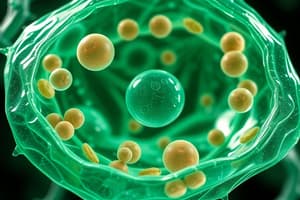Podcast
Questions and Answers
What is the primary function of palisade mesophyll cells?
What is the primary function of palisade mesophyll cells?
- Photosynthesis (correct)
- Water storage
- Support plant structure
- Gas exchange
Eukaryotic cells have ribosomes that are 70S in size.
Eukaryotic cells have ribosomes that are 70S in size.
False (B)
What is the process by which stem cells become specialized for functions?
What is the process by which stem cells become specialized for functions?
Differentiation
The formula for magnification is Magnification = Measured Size / _____ Size.
The formula for magnification is Magnification = Measured Size / _____ Size.
Match the following types of cells with their key features:
Match the following types of cells with their key features:
Which organelle is unique to prokaryotic cells?
Which organelle is unique to prokaryotic cells?
Gram-negative bacteria are more susceptible to antibiotics than gram-positive bacteria.
Gram-negative bacteria are more susceptible to antibiotics than gram-positive bacteria.
What type of cell is E. coli?
What type of cell is E. coli?
What is the primary function of root hair cells?
What is the primary function of root hair cells?
Red blood cells are highly flexible and can pass through capillaries due to their biconcave shape and lack of nucleus.
Red blood cells are highly flexible and can pass through capillaries due to their biconcave shape and lack of nucleus.
What is the main role of B cells in the immune response?
What is the main role of B cells in the immune response?
The _____ epithelium is found in the alveoli and is structured for efficient diffusion during gas exchange.
The _____ epithelium is found in the alveoli and is structured for efficient diffusion during gas exchange.
Match the following blood cell types with their primary features:
Match the following blood cell types with their primary features:
Which of the following tissues contains goblet cells for mucus secretion?
Which of the following tissues contains goblet cells for mucus secretion?
Fast-twitch muscle fibers are designed for sustained contractions and resist fatigue.
Fast-twitch muscle fibers are designed for sustained contractions and resist fatigue.
What is the function of mitochondria in root hair cells?
What is the function of mitochondria in root hair cells?
Flashcards
Cell Theory
Cell Theory
Cells are the basic unit of structure, function, and organization in living things.
Cell Differentiation
Cell Differentiation
Stem cells maturing into specific cells like muscle cells or neurons.
Prokaryotic Cell
Prokaryotic Cell
A type of cell lacking a nucleus and other membrane-bound organelles (e.g., bacteria).
Eukaryotic Cell
Eukaryotic Cell
Signup and view all the flashcards
Palisade Mesophyll Cells
Palisade Mesophyll Cells
Signup and view all the flashcards
Sperm Cell
Sperm Cell
Signup and view all the flashcards
Gram-Positive Bacteria
Gram-Positive Bacteria
Signup and view all the flashcards
Microscopy
Microscopy
Signup and view all the flashcards
Root Hair Cells Function
Root Hair Cells Function
Signup and view all the flashcards
White Blood Cells (WBCs)
White Blood Cells (WBCs)
Signup and view all the flashcards
Lymphocytes (T cells)
Lymphocytes (T cells)
Signup and view all the flashcards
Red Blood Cells (RBCs)
Red Blood Cells (RBCs)
Signup and view all the flashcards
Squamous Epithelium
Squamous Epithelium
Signup and view all the flashcards
Columnar Epithelium
Columnar Epithelium
Signup and view all the flashcards
Endothelial Tissue
Endothelial Tissue
Signup and view all the flashcards
Muscle Fiber Types
Muscle Fiber Types
Signup and view all the flashcards
Study Notes
Cell Structure and Function
- Cell Theory: Cells are the fundamental unit of structure, function, and organization in all living organisms.
- Differentiation: Stem cells specialize into specific cell types (e.g., muscle, neuron).
- Tissues: Groups of similar cells performing a function (e.g., epithelial, muscle, nervous).
- Organs: Tissues working together to perform a function (e.g., heart, lungs).
- Systems: Collections of organs performing a specific function (e.g., cardiovascular, respiratory).
- Prokaryotic Cells (e.g., Bacteria): Nucleoid, plasmids, 70S ribosomes, capsule, cell wall. Example: E. coli.
- Eukaryotic Cells (e.g., Plant and Animal): Plasma membrane, cytoplasm, nucleus, nucleolus, endoplasmic reticulum (smooth and rough), Golgi apparatus, vesicles, lysosomes, 80S ribosomes, mitochondria, centrioles.
- Plant-Specific Organelles: Cell wall, chloroplasts, vacuole, tonoplast, amyloplasts, plasmodesmata, pits. Example: Palisade mesophyll.
- Microscopy: Different types of microscopes (light, electron) allow viewing of cell structures.
- Light Microscopes: Advantages: Easy to use, affordable, can observe living cells. Limitations: Lower magnification, resolution than electron microscopes.
- Gram Staining: Distinguishes Gram-positive (thick peptidoglycan layer, penicillin-susceptible) and Gram-negative (thin peptidoglycan, outer membrane, resistant to some antibiotics) bacteria. Procedure: Crystal violet, iodine, alcohol wash, safranin.
- Cell Measurement: Magnification = Measured Size / Actual Size. Convert units (e.g., mm to µm).
Cell Specialization
- Palisade Mesophyll Cells: Photosynthesis, cylindrical shape, many chloroplasts, large vacuole, thin walls. Located in leaves.
- Sperm Cells: Haploid nucleus, acrosome (enzymes), mid-section (mitochondria), tail (motility). Male reproductive cell.
- Egg Cells: Haploid nucleus, large cytoplasm, zona pellucida and corona radiata (protection). Female reproductive cell.
- Root Hair Cells: Large surface area for water and nutrient absorption, partially permeable membrane, mitochondria for active transport.
- White Blood Cells (WBCs): Lymphocytes (T cells, B cells), Neutrophils (phagocytic). Immune response cells.
- Red Blood Cells (RBCs): Biconcave shape, no nucleus, maximizes hemoglobin, small and flexible.
Tissue Structure and Function
- Epithelial Tissue: Squamous epithelium (thin, efficient diffusion, found in alveoli, COPD affects it). Columnar epithelium (contains goblet cells, cilia move mucus/pathogens, found in trachea).
- Endothelial Tissue: Blood vessels (single squamous layer reduces friction, regulates blood flow/pressure, Atherosclerosis).
- Muscular Tissue: Skeletal muscle (multinucleated, striated, sliding filament theory: actin, myosin, calcium, ATP). Fast-twitch vs. slow-twitch fibers.
- Nervous Tissue: Neurons (myelinated, non-myelinated axons, synaptic transmission: neurotransmitters). Neurotransmitter imbalances affect health (e.g., Parkinson's, depression).
Studying That Suits You
Use AI to generate personalized quizzes and flashcards to suit your learning preferences.




